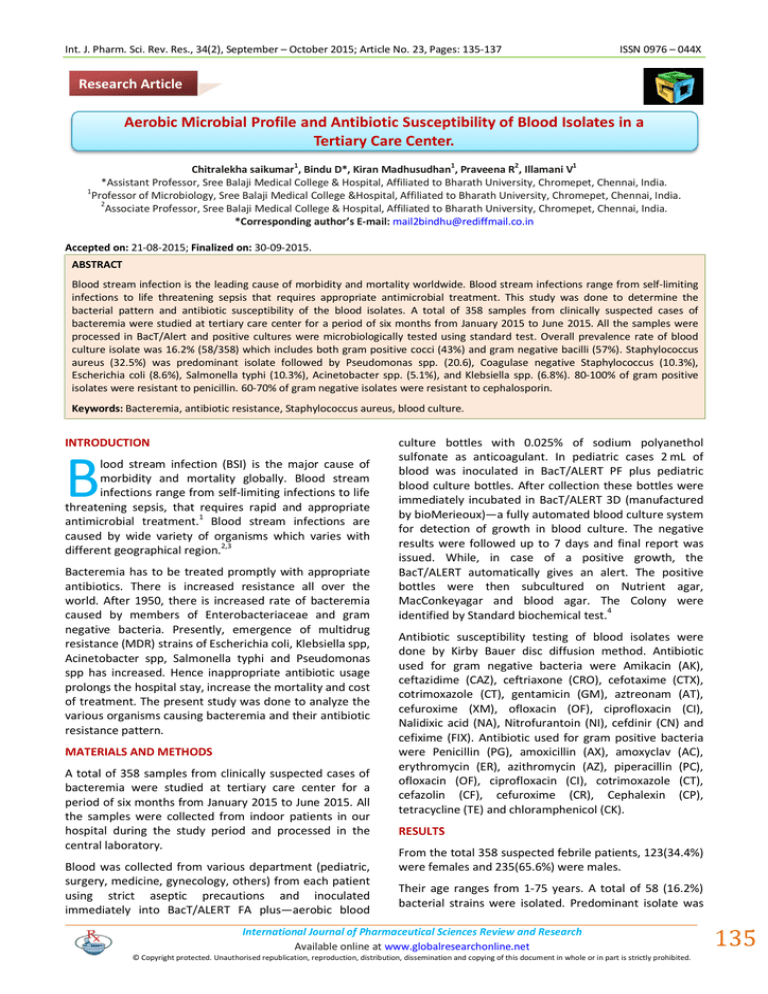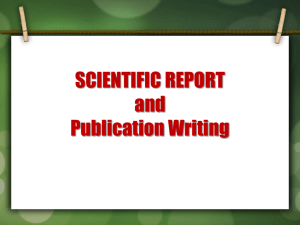Document 13310669
advertisement

Int. J. Pharm. Sci. Rev. Res., 34(2), September – October 2015; Article No. 23, Pages: 135-137 ISSN 0976 – 044X Research Article Aerobic Microbial Profile and Antibiotic Susceptibility of Blood Isolates in a Tertiary Care Center. 1 1 2 1 Chitralekha saikumar , Bindu D*, Kiran Madhusudhan , Praveena R , Illamani V *Assistant Professor, Sree Balaji Medical College & Hospital, Affiliated to Bharath University, Chromepet, Chennai, India. 1 Professor of Microbiology, Sree Balaji Medical College &Hospital, Affiliated to Bharath University, Chromepet, Chennai, India. 2 Associate Professor, Sree Balaji Medical College & Hospital, Affiliated to Bharath University, Chromepet, Chennai, India. *Corresponding author’s E-mail: mail2bindhu@rediffmail.co.in Accepted on: 21-08-2015; Finalized on: 30-09-2015. ABSTRACT Blood stream infection is the leading cause of morbidity and mortality worldwide. Blood stream infections range from self-limiting infections to life threatening sepsis that requires appropriate antimicrobial treatment. This study was done to determine the bacterial pattern and antibiotic susceptibility of the blood isolates. A total of 358 samples from clinically suspected cases of bacteremia were studied at tertiary care center for a period of six months from January 2015 to June 2015. All the samples were processed in BacT/Alert and positive cultures were microbiologically tested using standard test. Overall prevalence rate of blood culture isolate was 16.2% (58/358) which includes both gram positive cocci (43%) and gram negative bacilli (57%). Staphylococcus aureus (32.5%) was predominant isolate followed by Pseudomonas spp. (20.6), Coagulase negative Staphylococcus (10.3%), Escherichia coli (8.6%), Salmonella typhi (10.3%), Acinetobacter spp. (5.1%), and Klebsiella spp. (6.8%). 80-100% of gram positive isolates were resistant to penicillin. 60-70% of gram negative isolates were resistant to cephalosporin. Keywords: Bacteremia, antibiotic resistance, Staphylococcus aureus, blood culture. INTRODUCTION B lood stream infection (BSI) is the major cause of morbidity and mortality globally. Blood stream infections range from self-limiting infections to life threatening sepsis, that requires rapid and appropriate antimicrobial treatment.1 Blood stream infections are caused by wide variety of organisms which varies with different geographical region.2,3 Bacteremia has to be treated promptly with appropriate antibiotics. There is increased resistance all over the world. After 1950, there is increased rate of bacteremia caused by members of Enterobacteriaceae and gram negative bacteria. Presently, emergence of multidrug resistance (MDR) strains of Escherichia coli, Klebsiella spp, Acinetobacter spp, Salmonella typhi and Pseudomonas spp has increased. Hence inappropriate antibiotic usage prolongs the hospital stay, increase the mortality and cost of treatment. The present study was done to analyze the various organisms causing bacteremia and their antibiotic resistance pattern. MATERIALS AND METHODS A total of 358 samples from clinically suspected cases of bacteremia were studied at tertiary care center for a period of six months from January 2015 to June 2015. All the samples were collected from indoor patients in our hospital during the study period and processed in the central laboratory. Blood was collected from various department (pediatric, surgery, medicine, gynecology, others) from each patient using strict aseptic precautions and inoculated immediately into BacT/ALERT FA plus—aerobic blood culture bottles with 0.025% of sodium polyanethol sulfonate as anticoagulant. In pediatric cases 2 mL of blood was inoculated in BacT/ALERT PF plus pediatric blood culture bottles. After collection these bottles were immediately incubated in BacT/ALERT 3D (manufactured by bioMerieoux)—a fully automated blood culture system for detection of growth in blood culture. The negative results were followed up to 7 days and final report was issued. While, in case of a positive growth, the BacT/ALERT automatically gives an alert. The positive bottles were then subcultured on Nutrient agar, MacConkeyagar and blood agar. The Colony were identified by Standard biochemical test.4 Antibiotic susceptibility testing of blood isolates were done by Kirby Bauer disc diffusion method. Antibiotic used for gram negative bacteria were Amikacin (AK), ceftazidime (CAZ), ceftriaxone (CRO), cefotaxime (CTX), cotrimoxazole (CT), gentamicin (GM), aztreonam (AT), cefuroxime (XM), ofloxacin (OF), ciprofloxacin (CI), Nalidixic acid (NA), Nitrofurantoin (NI), cefdinir (CN) and cefixime (FIX). Antibiotic used for gram positive bacteria were Penicillin (PG), amoxicillin (AX), amoxyclav (AC), erythromycin (ER), azithromycin (AZ), piperacillin (PC), ofloxacin (OF), ciprofloxacin (CI), cotrimoxazole (CT), cefazolin (CF), cefuroxime (CR), Cephalexin (CP), tetracycline (TE) and chloramphenicol (CK). RESULTS From the total 358 suspected febrile patients, 123(34.4%) were females and 235(65.6%) were males. Their age ranges from 1-75 years. A total of 58 (16.2%) bacterial strains were isolated. Predominant isolate was International Journal of Pharmaceutical Sciences Review and Research Available online at www.globalresearchonline.net © Copyright protected. Unauthorised republication, reproduction, distribution, dissemination and copying of this document in whole or in part is strictly prohibited. 135 © Copyright pro Int. J. Pharm. Sci. Rev. Res., 34(2), September – October 2015; Article No. 23, Pages: 135-137 ISSN 0976 – 044X Staphylococcus aureus 19(32.7%), Frequency of bacterial isolates is shown in Figure 1. Figure 3: Antibiotic resistance pattern of Gram Negative blood isolates. CRO-Ceftriaxone, AT-Aztreonam, CT-Ciprofloxacin, AK- Amikacin, OF - Ofloxacin, GM - Gentamicin, NORNorfloxacin, Figure1: Distribution of blood isolates in blood culture. Antibiotic resistance pattern of the gram positive organism isolated from blood is shown in Figure 2. Resistance ranges from 0 to 100%. Streptococcus spp. is sensitive to all the antibiotics. CONS is 100% resistance to penicillin, 50-80% of isolates are resistant to amoxicillin, ofloxacin azithromycin and cephalosporin. 65-80% of the isolates are resistant to Azithromycin, ciprofloxacin, penicillin and cephalosporin.(figure2) CN - Cefdinir, XM - Cefuroxime, FIX - Cefixime, CAZ Ceftazidime (CAZ), NI – Nitrofurantoin, NA - Nalidixic acid, and CTX – Ceftaxime. DISCUSSION In the Present study 58 (16.2%) blood cultures showed positive growth. This Prevalence rate is relatively low than the previous studies Nigeria (44.9), Zimbabwe 37.1%, Gambia 34%, Pakistan(68.4%).5-8 It is in accordance with other workers (16.9)9, Ethiopia (18.2%)10, Nigeria (18.2%)11, Mawali (17.6%)12, Nepal (23.1%)13. The variation in prevalence of BSI across countries could be due to the difference in blood culture system, the study design, geographical location, nature of patient population, epidemiological difference of the etiological agents, seasonal variations, and difference in infection control policies between nations.2,10 In the present study, the gram positive accounts for 43% and 57% were gram negative isolates, It is in accordance 14 with other studies 52.7and 47.3% and Saudi Arabia 11 (62.2 and 33.8%) . AX-Amoxicillin, AC- Amoxyclav, CP-Cephalexin, CFCefazolin, CR-Cefuroxime, TE-Tetracycline, OF-Ofloxacin, CK-Chloramphenicol, CI-Ciprofloxacin, PC-Piperacillin, AZAzithromycin, ER-Erythromycin, CT-Cotrimoxazole, and PG-Penicillin. Staphylococcus aureus was the predominant organism causing blood stream infections in the present study, it is similar to the study in Nigeria15. Among the gram negative bacteria Pseudomonas spp. was predominant organism14,16 followed by Salmonella typhi. But in many studies it is E.coli/Kebsiella14, hence it differs in accordance with the geographical region and in hospitalized patients. One candida species was isolated in 17 our study similar to the few studies . Antibiotic resistance pattern of gram negative bacteria is shown Figure 3. 58 -67 % of Pseudomonas Spp. was resistant to all the drugs. 75% of Klebsiella spp. was resistant to all antibiotics. Almost all the species were resistant to nalidixic acid. (Figure 3) In our study the amikacin showed sensitivity to Pseudomonas and E.coli in accordance with the other 18 studies . 70-75% of Klebsiella, Acinetobacter isolates were multidrug resistant strains. 100% of CONS and 80% of S.aureus isolates were resistant to penicillin. Figure 2: Antibiotic resistance pattern of gram positive blood isolates. International Journal of Pharmaceutical Sciences Review and Research Available online at www.globalresearchonline.net © Copyright protected. Unauthorised republication, reproduction, distribution, dissemination and copying of this document in whole or in part is strictly prohibited. 136 © Copyright pro Int. J. Pharm. Sci. Rev. Res., 34(2), September – October 2015; Article No. 23, Pages: 135-137 Bacterial Profile of Blood Stream Infections In Children Less Than Three Years Old, J. Babylon Univ., 10(3), March 2005, 481-485. Piperacillin was effective for CONS. Ciprofloxacin was also sensitive for Pseudomonas. For the MDR isolates, there is need for further screening of ESBL, AmpC and Carbapenamase. CONCLUSION Staphylococcus aureus was the predominant organism. Eighty percentage of gram positive isolates were resistant to penicillin, azithromycin, and 60-80 % of gram negative isolates were resistant to cephalosporins and susceptibility also differs in the different species. Hence periodic monitoring of blood culture isolates and determination of susceptibility to antibiotics are necessary to improve the empirical therapy. REFERENCES 1. L. S. Young, G. L. Mandell, J. E. Bennet, and R. Dolin: “Sepsis syndrome,” Principle and Practice of Infectious Diseases: New York: Churchill Livingstone, 1995, pp. 690–705. 2. Gohel K, Jojera A, Soni S, Gang S, Sabnis R, Desai M, Bacteriological profile and drug resistance patterns of blood culture isolates in a tertiary care nephrourology teaching institute, Biomed Res Int, 2014, 153747. 3. 4. 5. Daniel RK, Scott AF, James MB, Sanjay S, Brief Report: incidence, etiology, risk factors, and outcome of hospital acquired fever. J Gen Intern Med, 21, 2006, 1184-1187. Cheesbrough M. District Laboratory Practical in countries, 2, 2000, 132-143. Martin MM, Chukwuemeka EN, Anne EA, Joseph UO, Simon EA, Bacterial isolates from blood cultures of children with suspected septicemia in calabar, Nigeria, BMC infect. Disease, 5, 2005, 110. 6. Obi CL, Mazarura E, Aerobic bacteria isolated from blood cultures of patients and their antibiotic susceptibilities in Harare, Zimbabwe. Cent Afr J Med, 42(12), 1996, 332-336. 7. Philip CH, Charles OO, Usman NAI, Ousman S, Samuel A, Naomi S, Simon A Donkor, Stephen R Howie, Mary Tapgun, Tumani Corrah, and Richard A Adegbola, Bacteremia in patients admitted to an urban hospital in West Africa. BMC Infect Dis, 7(2), 2007, 1794245. 8. Alaa H. Al-Charrakh, Ali M. Al-Muhana, Zainab H. Al-Saadi, ISSN 0976 – 044X 9. Majda Qureshi and Farooq Aziz. Prevalence of microbial isolates in blood cultures and their antimicrobial susceptibility profiles. Biomedica, 27(6), Jul-Dec 2011, 136139. 10. Dagnew M, Yismaw G, Gizachew M, Gadisa A, Abebe T, Tadesse T, Alemu A, Mathewos B, Bacterial profile and antimicrobial susceptibility pattern in septicemia suspected patients attending Gondar University Hospital, Northwest Ethiopia. BMC Res Notes, 6, 2013, 283. 11. Nwadioha I, Nwokedi EOP, Kashibu E, Odimayo MS, Okwori EE, A review of bacterial isolates in blood cultures of children with suspected septicemia in a Nigerian. Afr J Microbiol Res, 4(4), 2010, 222-225. 12. Archibald LK, McDonald LC, Nwanyanwu O, Kazembe P, Dobbie H, Tokars J, Rellar LB, Javis WR. A hospital-based prevalence survey of bloodstream infections in febrile patients in Malawi: implications for diagnosis and therapy. J Infect Dis, 181, 2000, 1414-1420. 13. Amatya NM, Shrestha B, Lekhak B, Etiological agents of bacteremia and antibiotic susceptibility pattern in Kathmandu hospital. J Nepal Med Assoc, 46(167), 2007, 112-118. 14. Usha Arora and Pushpa Devi. Bacterial Profile of Blood stream infections and antibiotic resistance pattern of isolates, JK science, 9(4), Oct-Dec 2007, 186-189. 15. Adeleke SI, Belonwu RO. Bacterial Isolates in Neonatal septicemia in Kano, Nigeria (2002 – 2003), Pinnacle Int. J. Med. Sci, 1(1), 2006, 17-20. 16. Asghar AH. Frequency and antimicrobial susceptibility patterns of bacterial pathogens isolated from septicemic patients in Makkah hospitals, Saudi Med J, 27(3), 2006, 361-367. 17. Mehta M, Dutta P and Gupta V. Antimicrobial susceptibility in blood infection from teaching hospital, India, JPn. J infectious dis, 58(3), 2005, 174—176. 18. Latif S, Anwar MS and Ahmad I. Bacterial pathogens responsible for blood stream infections and pattern of drug resistance in tertiary care Hospital, Lahore. Biomed, 25, Jul – Dec 2009, 101—105. Source of Support: Nil, Conflict of Interest: None. International Journal of Pharmaceutical Sciences Review and Research Available online at www.globalresearchonline.net © Copyright protected. Unauthorised republication, reproduction, distribution, dissemination and copying of this document in whole or in part is strictly prohibited. 137 © Copyright pro






